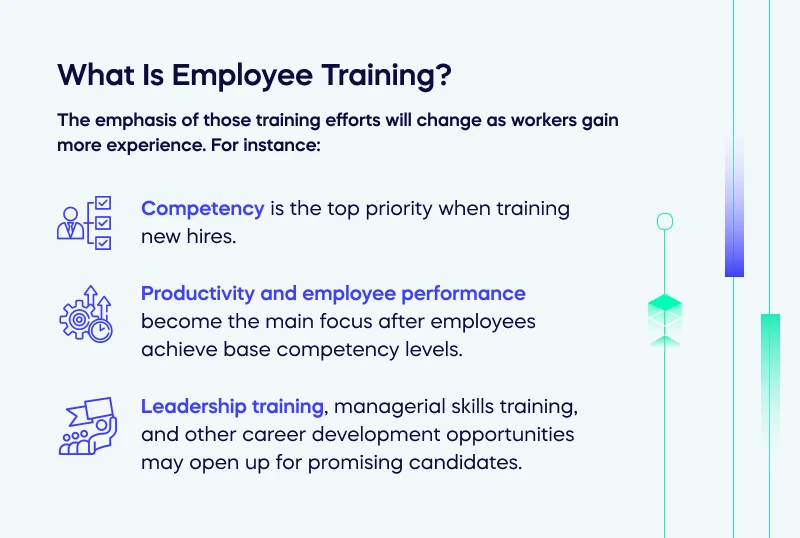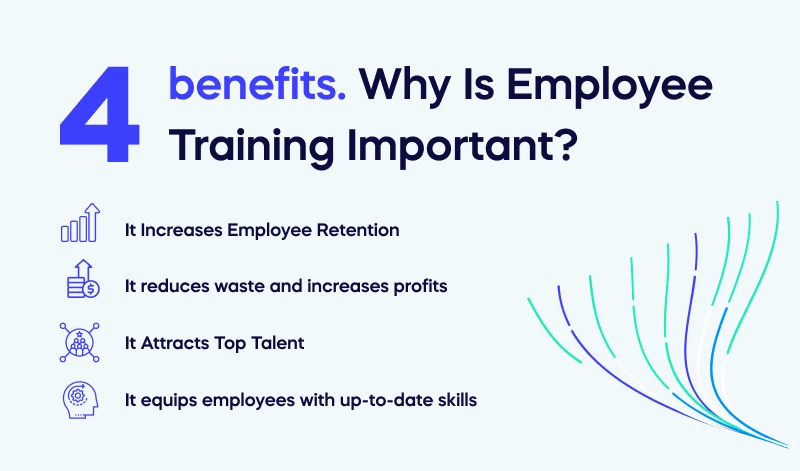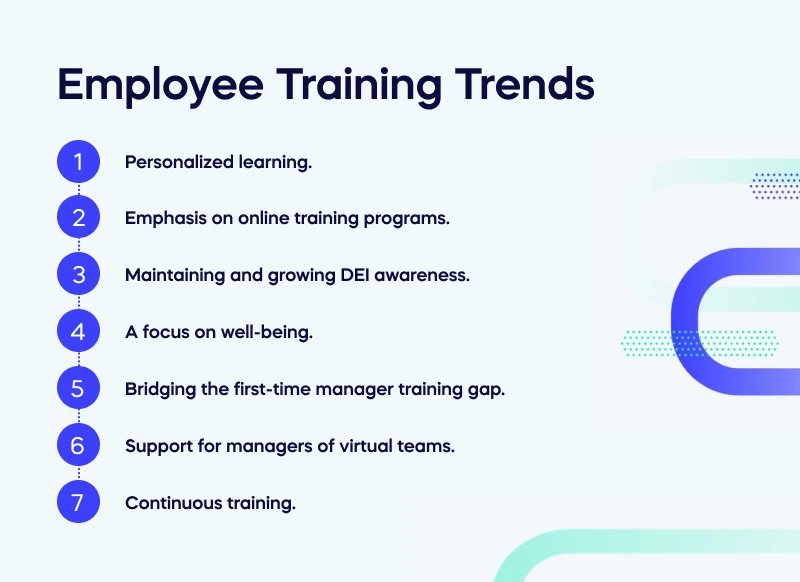Employee Training

Table of contents
- The Complete Guide to Employee Training
- Employee Training: History and Background
- What Is Employee Training?
- Why Is Employee Training Important?
- Types of Employee Training
- Employee Training Trends
- How has employee training changed?
- Best Practices and Strategies for Improving Employee Training
- Employee Training Forecast
- Further Reading
The Complete Guide to Employee Training
Practical employee training is essential for a world where staff is the central resource of any enterprise, as it impacts employee retention, morale, and productivity. These elements make employee development and training the essential components of growth.
This guide will cover employee training in-depth and explore a brief history of its benefits, several types of employee training, and more.
This guide was also updated in January 2023 according to the new digital transformation trends during COVID-19 and emerging metaverse technologies.
Employee Training: History and Background
Throughout history, professional training has played a central role in the workplace to improve a company’s reputation and complete business goals.
Until recently, the learning experience usually took the form of apprenticeships and on-the-job training in person. New hires would start working for their employer, often at a young age, and immerse themselves in their new role until they attained mastery.
During the 1800s, industrial technology entered the work world, and with that new technology came the need for more specialized skills. Formal training programs quickly became commonplace at factories and increased into other businesses.
Throughout the 20th century, workplace training became more and more common until it eventually became standard practice in most organizations.
Over the past several decades, computers, mobile devices, and digital training tools have become more prominent, resulting in blended training programs that use human trainers and computers.
The Covid-19 pandemic completely changed employee training because working from the office was unsafe. Learning was carried out remotely, using online training tools and video conferencing. Over the past few years, this has remained the norm for many hybrid workers, marking a shift in the training process from traditional in-person training to e-learning as companies continue upskilling employees and recruiting top talent.
Continuous learning is the favored training philosophy of training employees due to the constant rate of technological disruption and change. New and existing employees must quickly become skilled at constantly learning how to use new software and adapt to new approaches to their tasks throughout the year as their employee continuously identifies new knowledge gaps.
What Is Employee Training?

Employee training programs provide workers with education and specific skills training directly related to their role. Training begins early in the career, usually on the very first day, then continues throughout the employee lifecycle.
However, the emphasis of those training efforts will change as workers gain more experience. For instance:
- Competency is the top priority when training new hires.
- Productivity and employee performance become the main focus after employees achieve base competency levels.
- Leadership training, managerial skills training, and other career development opportunities may open up for promising candidates.
Developing an effective training program can be a challenge, especially since today’s workplace is evolving so rapidly, but there are benefits to successfully implementing a training program.
Why Is Employee Training Important?

Employees must be competent at their jobs to add value to an organization, which is the most fundamental reason why training is essential.
Besides maintaining employee competency, training also offers benefits such as:
1. It Increases Employee Retention
LinkedIn Learning research shows that 94% of employees would remain with an organization for extended periods if their employer invested in staff learning and development opportunities.
Investing in your training and employee growth initiatives will help to ensure you don’t have to constantly search for new talent, instead focusing on supporting existing staff to reach their full potential, driving organizational performance and growth. In addition, when managers are trained in succession planning, they can quickly fill empty roles, saving money and time.
2. It reduces waste and increases profits
Employee training programs are a wise investment – yet not investing in them can be costly. For instance, hiring and retraining staff that has not been given the proper instruction at first could cost you up to £12,000 for those on an average UK salary of £27,721 or as much as £20,000 if your employees earn above-average wages, around £60,000. Ultimately, investing in training in the long term becomes far less expensive than avoiding it.
3. It Attracts Top Talent
Millennials and Gen Z job seekers prioritize learning opportunities, with Forbes research showing that 83% of Gen Z state that learning opportunities are an essential factor to them when applying for jobs. Simply put, if your training program isn’t attractive to millennials and Gen Z-ers, they will pass over your company and turn to competitors.
4 It equips employees with up-to-date skills
To progress as a business, you must train with an eye to the future. Provide your personnel training on cutting-edge industry trends and technology to make them more competent and educated workers capable of producing exceptional work for your company.
Though training has challenges and disadvantages, such as costs, the benefits usually outweigh the disadvantages and positively impact the organization.
“There are only two ways in which a manager can impact an employee’s output: motivation and training. If you are not training, then you are basically neglecting half the job.”
-Andy Grove
Types of Employee Training
One way to categorize employee training is by defining training methods, which include:
- One-on-one mentor systems: Managers or experienced employees can guide less experienced employees through mentorship, advice, or skills training. A software super-user, for instance, can act as a go-to resource for information or education on a given software platform.
- Classroom training: Although online courses and technology are helpful for the learning process, classroom training allows employees to ask questions and engage with educators as part of an in-person training program.
- Online courses: Online education, such as on-demand video courses, has skyrocketed in popularity over the past several years, a trend accelerated by the COVID-19 pandemic. The World Economic Forum, for example, predicts that education technology investments will grow to over $350 billion by 2025, partly driven by the pandemic.
- In-app digital training solutions: Applications can deliver many forms of training, such as software walkthroughs, chatbots, and context-based guidance like a contextual help system. Digital training solutions that offer this type of training allow employees to receive hands-on, personalized training without managerial input.
Each training method has its advantages, disadvantages, and use cases, which is why most employee training programs rely on several methods.
Employee Training Trends

History has shown that employee training is not a static industry and will continue to evolve rapidly in the coming years.
Several trends indicate the direction that employee training is headed, such as:
- Personalized learning: Personalization is essential to ensuring employees engage in training relevant to their needs.
- Emphasis on online training programs: Online training is the key to ensuring that the employee skills gap is filled efficiently and enables employees to gain knowledge at their own pace.
- Maintaining and growing DEI awareness: Training programs must focus on hard skills and soft skills, promoting a solid ability to communicate effectively by fostering respect for people’s individual needs and improving emotional intelligence.
- A focus on well-being: Employees demand more significant consideration of their mental and physical needs. Companies can also benefit from providing well-being programs by maintaining a healthy, productive workforce with higher retention rates.
- Bridging the first-time manager training gap: Training managers is an essential yet often neglected element of the learning process. When companies train managers, they are ensuring that they are also indirectly training employees and ensuring that soft skills such as communication are identified as managers are trained to look out for them.
- Support for managers of virtual teams: Hybrid working presents many challenges for managers, and companies must support managers to support their teams using virtual communication skills. Institutional knowledge is essential here, as managers use the understanding of their company goals and culture to maintain shared values for new hires who may be in the office only a few days a week or completely WFH.
- Continuous training: The technology revolution fuels workplace change, allowing employees to learn new skills continually. A constant training program can also enable employees to maintain high job performance as their skills gaps are quickly filled.
The technology revolution is perhaps the most prominent trend influencing the modern workplace and employee training.
How has employee training changed?
Today’s workplace has become a fast-paced digital environment, which has led to changes in the way employers train and in the way that employees learn.
Digitally-powered training programs are standard features in the modern workplace, which introduce new possibilities for employee training, such as:
- Micro-training, or just-in-time training, which delivers practical information as it is needed
- Software tutorials that provide automated instruction directly inside the application.
- The ability to personalize training content to meet an employee’s individual needs.
- Training can be conducted remotely, either by staff or from an automated training platform, such as a DAP.
Digital training tools will never fully replace humans, but they are growing in popularity and will continue to see more use in the years ahead.
Best Practices and Strategies for Improving Employee Training
Every organization is unique and every workforce has different learning needs, so training programs will also differ from company to company.
However, there are several best practices and principles that hold true when designing training programs, regardless of the circumstances:
- Focus on improving the employee experience, which will increase engagement, motivation, and morale
- To further boost engagement and morale, personalize the training’s content and format to suit the needs of the individual
- Take advantage of digital training solutions, such as digital adoption platforms, which can dramatically improve training outcomes and improve the digital employee experience
- Set measurable training goals that extend beyond productivity to include other key goals, such as employee satisfaction, workplace safety, and organizational communication
- To make the most of the program over the long term, track its performance and continually make adjustments
Employee training is an investment that comes with its own risks and rewards. Viewing it through that lens can help managers and business leaders make the most appropriate decisions when designing and implementing their programs.
Employee Training Forecast
Employee training has evolved considerably in recent history, mainly due to the introduction of new technological paradigms born out of Covid-19 and the metaverse. The industrial revolution fueled the growth of standardized employee training programs, and the digital revolution drove the adoption of new modes of digital training.
Today, technological advancements and digital adoption skills are essential, making employee training and development programs the core of any business that desires a competitive edge.
In the coming years, digital technology will continue to advance and propel change within the workplace. On the one hand, these changes will require employers to invest more in training employees and employees to commit more time and energy to learning. On the other, these advances will offer up new training solutions that are more efficient and effective to help businesses create resilience against future technological disruption.
Further Reading
Here are a few resources that offer more in-depth information on employee training, learning, and development:
- Employee Training Best Practices | WalkMe Blog
- Employee Training Remotely | WalkMe Blog
- Training Software’s Impact on Employee Productivity | WalkMe Blog
Frequently asked questions
The most common type of employee training is orientation or onboarding. Effective onboarding is essential, as BambooHR reports that those with a positive experience are 18 times more likely to remain loyal and committed to their employer.
An employee training program includes many stages. First, develop learning objectives for the individual and the business, and design the training. Next, plan and implement the training program with employees, and review the training program. An employee training program can increase retention. Forbes research suggests that 74% of Gen Z and millennials plan to quit their jobs in 2023 due to a lack of skills-building opportunities.